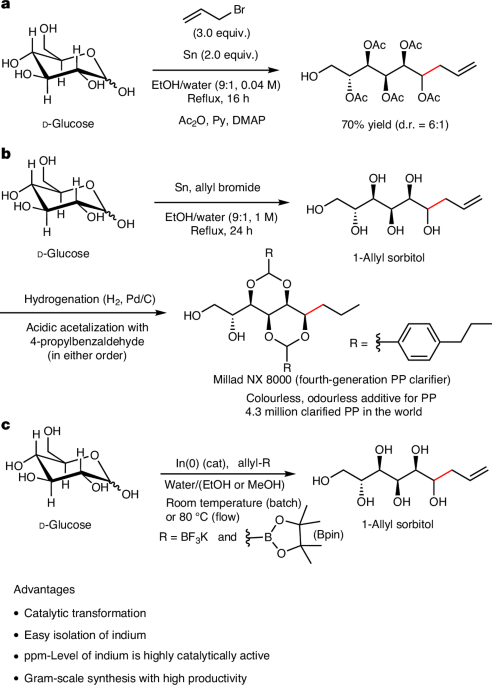Hernández-Fernández, J., Puello-Polo, E. & Marquez, E. Identifying, quantifying, and recovering a sorbitol-type petrochemical additive in industrial wastewater and its subsequent application in a polymeric matrix as a nucleating agent. Molecules 28, 4948 (2023).
Milliken invests to meet global demand for PP clarifier. Addit. Polym. 2014, 7 (2014).
Paben, J. APR gives recyclability thumbs up to PP additive. Resource Recycling (5 September 2019); https://resource-recycling.com/plastics/2019/09/05/apr-gives-recyclability-thumbs-up-to-pp-additive/
Market volume of polypropylene worldwide from 2015 to 2022, with a forecast for 2023 to 2030 (in million metric tons). Statista https://www.statista.com/statistics/1245169/polypropylene-market-volume-worldwide (2023).
Tullo, A. H. Making clearer polypropylene. Chem. Eng. News 88, 34–36 (2010).
Lin, M.-H. et al. Enabling technologies in carbohydrate chemistry: automated glycan assembly, flow chemistry and data science. Chem. Bio. Chem. 24, e202200607 (2023).
Zhou, F. & Li, C.-J. En route to metal-mediated and metal-catalysed reactions in water. Chem. Sci. 10, 34–46 (2019).
Hanessian, S. Total Synthesis of Natural Products: The ‘Chiron’ Approach (Pergamon Press, 1983).
Hanessian, S., Giroux, S. & Merner, B. L. Design and Strategy in Organic Synthesis: From the Chiron Approach to Catalysis (Wiley-VCH, 2013).
Newhouse, T., Baran, P. S. & Hoffmann, R. W. The economies of synthesis. Chem. Soc. Rev. 38, 3010–3021 (2009).
Trost, B. M. The atom economy—a search for synthetic efficiency. Science 254, 1471–1477 (1991).
Wender, P. A., Verma, V. A., Paxton, T. J. & Pillow, T. H. Function-oriented synthesis, step economy, and drug design. Acc. Chem. Res. 41, 40–49 (2008).
Wei, X.-F., Shimizu, Y. & Kanai, M. An expeditious synthesis of sialic acid derivatives by copper(I)-catalyzed stereodivergent propargylation of unprotected aldoses. ACS Cent. Sci. 2, 21–26 (2016).
Chung, K. & Waymouth, R. M. Selective catalytic oxidation of unprotected carbohydrates. ACS Catal. 6, 4653–4659 (2016).
Kan, J. et al. Umpolung carbonyls enable direct allylation and olefination of carbohydrates. Sci. Adv. 8, eabm6840 (2022).
Schmid, W. & Whitesides, G. M. Carbon-carbon bond formation in aqueous ethanol: diastereoselective transformation of unprotected carbohydrates to higher carbon sugars using allyl bromide and tin metal. J. Am. Chem. Soc. 113, 6674–6675 (1991).
Kim, E., Gordon, D. M., Schmid, W. & Whitesides, G. M. Tin- and indium-mediated allylation in aqueous media: application to unprotected carbohydrates. J. Org. Chem. 58, 5500–5507 (1993).
Petrier, C. & Luche, J. L. Allylzinc reagents additions in aqueous media. J. Org. Chem. 50, 910–912 (1985).
Nokami, J., Okawara, R., Otera, J. & Sudo, T. Allylation of aldehydes and ketones in the presence of water by allylic bromides, metallic tin, and aluminum. Organometallics 2, 191–193 (1983).
Chan, T.-H. & Li, C.-J. A concise chemical synthesis of (+)-3-deoxy-d–glycero–d–galacto-nonulosonic acid (KDN). J. Chem. Soc. Chem. Commun. 1992, 747–748 (1992).
Li, C.-J. & Chan, T. H. Organometallic reactions in aqueous media with indium. Tetrahedron Lett. 32, 7017–7020 (1991).
Tan, K.-T., Chng, S.-S., Cheng, H.-S. & Loh, T.-P. Development of a highly α-regioselective metal-mediated allylation reaction in aqueous media: new mechanistic proposal for the origin of α-homoallylic alcohols. J. Am. Chem. Soc. 125, 2958–2963 (2003).
Kumar, D., Vemula, S. R., Balasubramanian, N. & Cook, G. R. Indium-mediated stereoselective allylation. Acc. Chem. Res. 49, 2169–2178 (2016).
Xie, C. et al. Dibenzylidene sorbitol (DBS)-based compounds, compositions and methods for using such compounds. US patent 2007/0249850 (2007).
Xie, C. Substituted alditol compounds, compositions, and methods. US patent 7,888,454 (2011).
Yus, M., González-Gómez, J. C. & Foubelo, F. Catalytic enantioselective allylation of carbonyl compounds and imines. Chem. Rev. 111, 7774–7854 (2011).
Mlynarski, S. N., Schuster, C. H. & Morken, J. P. Asymmetric synthesis from terminal alkenes by cascades of diboration and cross-coupling. Nature 505, 386–390 (2014).
Denmark, S. E. & Fu, J. Catalytic enantioselective addition of allylic organometallic reagents to aldehydes and ketones. Chem. Rev. 103, 2763–2794 (2003).
Schneider, U., Ueno, M. & Kobayashi, S. Catalytic use of indium(0) for carbon−carbon bond transformations in water: general catalytic allylations of ketones with allylboronates. J. Am. Chem. Soc. 130, 13824–13825 (2008).
Molander, G. A., Cavalcanti, L. N., Canturk, B., Pan, P. S. & Kennedy, L. E. Efficient Hydrolysis of Organotrifluoroborates via Silica Gel and Water. J. Org. Chem. 74, 7364–7369 (2009).
Saloranta, T. et al. From mannose to small amphiphilic polyol: perfect linearity leads to spontaneous aggregation. Cryst. Growth Des. 16, 655–661 (2016).
Paquette, L. A. & Mitzel, T. M. Addition of allylindium reagents to aldehydes substituted at Cα or Cβ with heteroatomic functional groups. Analysis of the modulation in diastereoselectivity attainable in aqueous, organic, and mixed solvent systems. J. Am. Chem. Soc. 118, 1931–1937 (1996).
Gordon, D. M. & Whitesides, G. M. Indium-mediated allylations of unprotected carbohydrates in aqueous media: a short synthesis of sialic acid. J. Org. Chem. 58, 7937–7938 (1993).
Coley, C. W. et al. A robotic platform for flow synthesis of organic compounds informed by AI planning. Science 365, eaax1566 (2019).
Nambiar, A. M. K. et al. Bayesian optimization of computer-proposed multistep synthetic routes on an automated robotic flow platform. ACS Cent. Sci. 8, 825–836 (2022).
Shields, B. J. et al. Bayesian reaction optimization as a tool for chemical synthesis. Nature 590, 89–96 (2021).
Hartman, R. L., McMullen, J. P. & Jensen, K. F. Deciding whether to go with the flow: evaluating the merits of flow reactors for synthesis. Angew. Chem. Int. Ed. 50, 7502–7519 (2011).
Johnson, M. D. et al. Continuous liquid vapor reactions part 1: design and characterization of a reactor for asymmetric hydroformylation. Org. Process Res. Dev. 20, 888–900 (2016).


